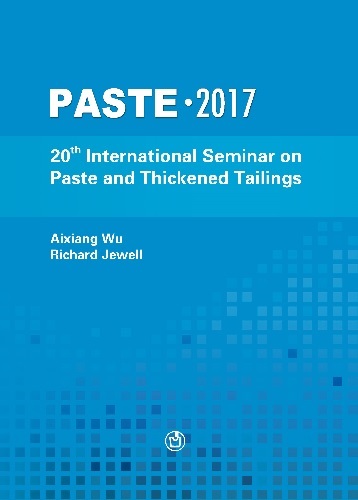Thickened tailings deposition for closure

|
Authors: Thompson, N; Moreno, P |
DOI https://doi.org/10.36487/ACG_rep/1752_25_Thompson
Cite As:
Thompson, N & Moreno, P 2017, 'Thickened tailings deposition for closure', in A Wu & R Jewell (eds), Paste 2017: Proceedings of the 20th International Seminar on Paste and Thickened Tailings, University of Science and Technology Beijing, Beijing, pp. 226-234, https://doi.org/10.36487/ACG_rep/1752_25_Thompson
Abstract:
The strategic implementation of a thickened tailings system for an existing conventional TSF can be beneficial in terms of significantly reducing the required post-operational earthworks and the time to achieve final closure. One of the most challenging aspects of the successful closure of a TSF is the long-term water management of the tailings surface. A typical concave-shaped, conventional paddock TSF could be transitioned to have a convex, thickened tailings surface towards the end of operations through modifying the tailings disposal strategy to create a water-shedding final landform, limiting the amount of surface re-shaping and borrow material required. This would also maximise the tailings storage capacity while generating a facility profile that would be significantly more amenable to closure. Challenges that would need to be explored and assessed before implementing such a strategy relate to the change from conventional to thickened tailings deposition and include characterising the slurry, adjusting the disposal methodology to include central discharge, assessing the impact of depositing thicker tailings over the existing beach, and modifying the supernatant water management plan. This paper discusses the concept of ‘deposition for closure’ using thickened tailings that is currently relatively uncommon worldwide; however, is becoming increasingly attractive due to more stringent closure requirements and enhanced thickening technology. The implementation of this concept is currently in the early stages for a TSF at a gold mine in Ghana, with the knowledge gained from this project used as the basis for presenting the potential advantages of such a strategy, as well as the likely issues and challenges encountered.
References:
Moreno, J., Thompson, N. and Hore, C. 2014, ‘Selection criteria for two alternative thickened slurries to be deposited over conventional tailings: storage capacity and liquefaction’, in R.J. Jewell, A.B. Fourie, P.S. Wells and D. Van Zyl (eds), Proceedings of the 17th International Seminar on Paste and Thickened Tailings, Australian Centre for Geomechanics, Perth.
Robertson, P.K. 2010, ‘Evaluation of flow liquefaction and liquefied strength using the cone penetration test’, Journal of Geotechnical and Geoenvironmental Engineering, vol. 136, no. 6, pp. 842-853.
Robins, M. 2004, ‘Closure of tailings facilities: current practice review and guidelines for success’, Faculty of Engineering and the Built Environment.
© Copyright 2026, Australian Centre for Geomechanics (ACG), The University of Western Australia. All rights reserved.
View copyright/legal information
Please direct any queries or error reports to repository-acg@uwa.edu.au
View copyright/legal information
Please direct any queries or error reports to repository-acg@uwa.edu.au